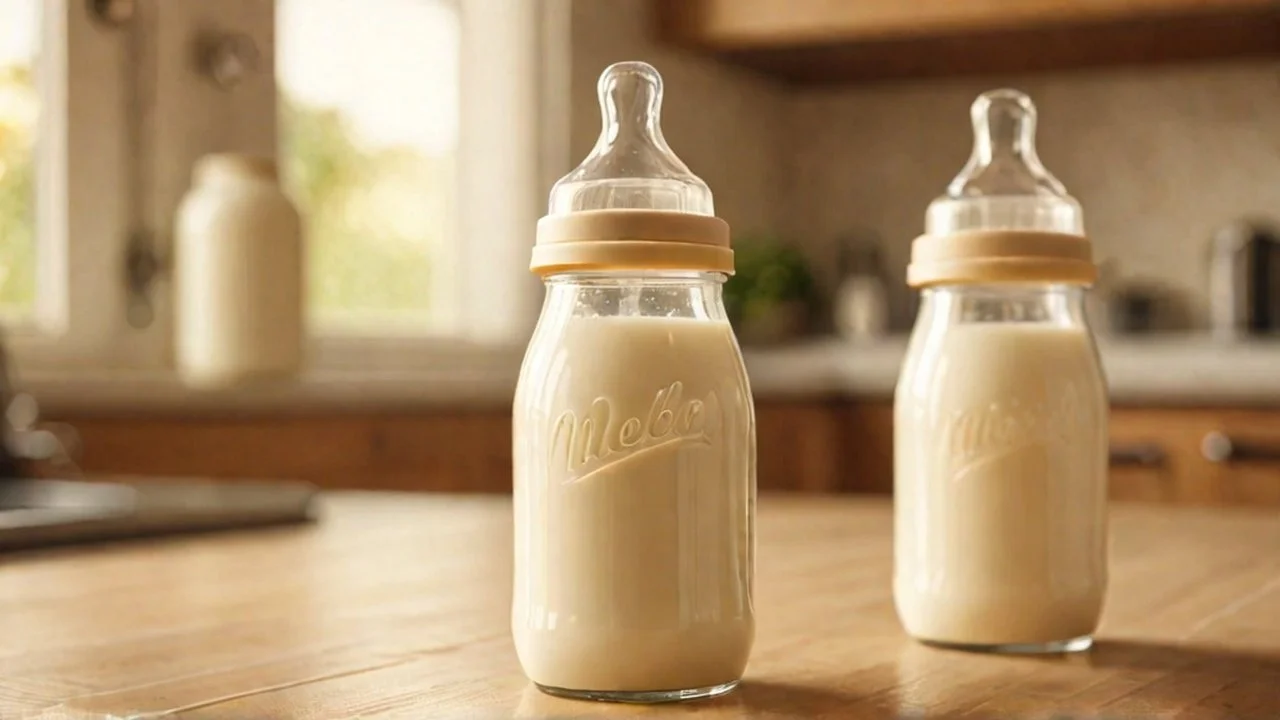Breast Milk: The Liquid Gold
Breast milk is often referred to as "liquid gold" for newborns due to its profound benefits for infant health and development. Its unique composition not only provides all the essential nutrients a baby needs in the early stages of life but also plays a vital role in building a strong immune system and promoting long-term well-being. Breast milk is often referred to as "liquid gold" for newborns due to its profound benefits for infant health and development. Its unique composition not only provides all the essential nutrients a baby needs in the early stages of life but also plays a vital role in building a strong immune system and promoting long-term well-being."Breastmilk is nature’s ultimate superfood, packed with everything your baby needs for a healthy start. Best Breastmilk Warmer. It’s not just nutrition—each drop is filled with antibodies, enzymes, and growth factors tailored perfectly for your little one’s development. But beyond the science, breastfeeding is a beautiful, intimate experience that strengthens the emotional bond between mom and baby, creating moments of closeness that last a lifetime. Together, it’s nourishment and love in its purest form."
The Wonders of Breastfeeding: More Than Just a Snack Break for Your Baby!
Welcome to the wild, wonderful world of breastfeeding, where your body becomes an all-in-one restaurant, pharmacy, and cuddle machine for your baby. Yep, you're basically a superhero in yoga pants. So, let’s break it down—why breastfeeding is not just about food, but a whole lot more (and why it’s worth every late-night feed and milk-stained shirt).
The Ultimate Superfood (Sorry, Kale)
Breastmilk is like nature’s customized meal plan for your baby. Forget the trendy diets—this stuff is packed with everything your little one needs to grow big, strong, and hopefully sleep through the night (eventually). Here’s what makes breastmilk the true MVP of baby food:
Antibodies galore! Breastmilk is packed with immune-boosting goodies like antibodies that help protect your baby from infections. It's like sending your newborn to battle with a tiny shield and sword—so when they inevitably lick that random object off the floor, they're at least better equipped for it.
Growth factors: Nope, these aren't some weird superhero terms—growth factors help your baby’s organs, muscles, and brain develop at lightning speed. Basically, breastmilk is like a cheat code for leveling up your baby’s body.
Digestive enzymes: Not only does breastmilk come with all the nutrients, but it’s also got its own set of enzymes to help your baby digest it perfectly. Think of it like a self-cleaning oven—efficient and magical!
1. Nutritional Components of Breast Milk
Breast milk is specially tailored to meet the nutritional needs of infants. It contains a perfect balance of proteins, fats, carbohydrates, vitamins, and minerals that are easy for the baby to digest. Key nutrients include:
Proteins: Whey and casein, which are essential for growth and tissue repair.
Fats: Critical for brain development, vision, and energy.
Lactose: A carbohydrate that provides energy and helps with calcium absorption.
Breast milk also contains bioactive components that formula cannot replicate, such as enzymes, hormones, and growth factors, which help in digestion, immune system function, and overall growth. Best AntiColic Bottles
2. Immune System and Disease Protection
One of the most powerful benefits of breast milk is its role in building the baby's immune system. During the first few days of breastfeeding, the mother produces colostrum, a thick, yellowish fluid rich in antibodies, particularly immunoglobulin A (IgA). These antibodies coat the baby's digestive tract, forming a protective barrier against harmful pathogens and supporting the development of the infant’s gut microbiota.
Key components that enhance immunity:
Antibodies (like IgA, IgG, IgM): Protect against infections such as diarrhea, respiratory issues, and ear infections.
Lactoferrin: Binds iron and inhibits bacterial growth.
Lysozyme: An enzyme that protects against harmful bacteria.
Human Milk Oligosaccharides (HMOs): Prebiotics that nourish beneficial gut bacteria and further protect against infections.
3. Biological Explanation: Tailored Nutrition
Breast milk adapts to the changing needs of a growing infant. For example, the fat content of breast milk increases during a single feeding to satiate the baby, and the composition of milk changes as the baby ages. This is often referred to as a "dynamic" nutritional source. The mother’s immune system responds to pathogens the baby is exposed to, producing specific antibodies that are transferred through the milk.
This biological adaptability makes breast milk an essential part of the newborn’s first-line defense against illnesses and infections. It also promotes the healthy development of the baby’s gut lining and supports a balanced microbiome, which is crucial for digestion and immunity.
4. Long-term Benefits
Breastfed babies are less likely to suffer from chronic conditions later in life, such as:
Obesity: Breastfeeding helps regulate appetite and body fat.
Type 1 and 2 Diabetes: Early breastfeeding has been associated with a reduced risk of diabetes.
Allergies and Asthma: Exclusive breastfeeding for the first six months can lower the risk of respiratory diseases and allergies.
Cognitive Development: Studies show that children who are breastfed have higher IQ scores and better cognitive outcomes due to the long-chain polyunsaturated fatty acids found in breast milk, which are crucial for brain development.
A Bond Like No Other (Cue the Sappy Music)
Let’s get real for a second—yes, breastfeeding is nourishing, but it’s also bonding in its purest form. Those quiet moments in the middle of the night, when it’s just you, your baby, and the dim glow of the fridge light? That’s when the magic happens.
Eye contact: Your baby’s eyes are still adjusting to the world, and guess what? The perfect distance for their developing vision is exactly from their face to yours while breastfeeding. Coincidence? Nope. Nature just made sure your baby can really see you, helping build that emotional connection. Best Breastmilk Boosting supplement
Oxytocin—the love hormone: Breastfeeding releases oxytocin in both you and your baby. It’s basically the warm-fuzzy-feeling hormone that makes you fall even more in love with your little one. Oxytocin also helps your uterus contract back to its normal size (double win!).
The Science-y Stuff: How Does This Work, Anyway?
Okay, let’s dive into the biology of breastfeeding. It’s not magic (though it feels like it sometimes), it’s a beautifully orchestrated process between you and your baby.
Supply and demand: Breastfeeding works on a simple but brilliant principle: the more your baby feeds, the more milk your body makes. It’s like a build-your-own-supply store. Your body listens to how much your baby needs and adjusts accordingly. Best Breast Pump
Colostrum: The Liquid Gold: In the first few days after birth, your body produces colostrum, also known as liquid gold because it’s packed with nutrients, antibodies, and a high protein content. This stuff is the VIP of breastmilk—super thick, creamy, and absolutely essential for your baby’s immune system. Plus, it’s like giving your baby their very first energy drink (don’t worry, it’s safe!).
Milk transitions: After the colostrum phase, your milk "comes in" (hello, engorgement!), and it transitions to regular breastmilk, which changes to meet your baby’s needs as they grow. Early milk is more watery and full of lactose (think of it like a thirst-quenching smoothie), while later milk is richer in fat (kind of like adding avocado toast to the menu).
More Than Just Nutrition
Breastfeeding isn't just about keeping your baby fed—it does so much more! For starters, studies show breastfeeding can lead to higher IQ scores for babies. (So, yep, you’re raising a future genius. No big deal.) But that’s not all:
Reduced risks: Breastfeeding lowers the risk of sudden infant death syndrome (SIDS), allergies, asthma, and even ear infections. Basically, it’s like giving your baby an all-access pass to better health.
Mom benefits too! Not to leave you out—breastfeeding burns calories (hello, post-baby fitness plan!), lowers your risk of certain cancers, and can delay the return of your period. That's right, Mother Nature says, “You just made a human, take a break!”
When It Gets Tough (and It Will)
Let’s be real—breastfeeding can be hard. Like, cry-into-your-nursing-pad hard. And that’s okay! It takes time, patience, and sometimes a lactation consultant on speed dial. If you’re feeling stressed, know that you're not alone. You’ve got this! Every feed, every attempt, is a win. Best Lactation Cookies to boost milk production.
Remember: if breastfeeding doesn’t work out, or if you’re supplementing with formula, you’re still an amazing mom. What matters most is that your baby is fed, healthy, and loved—whether that’s from the breast, bottle, or a combo of both.
Final Thoughts: You’re a Rockstar
So, new moms, as you navigate this beautiful, messy, exhausting, and rewarding journey, remember that your body is doing something truly remarkable. Whether you breastfeed for a week, a month, a year (or anywhere in between), every drop is a gift of health, love, and comfort to your baby.
You’re creating memories, forming bonds, and giving your little one the best start in life. Plus, you’re learning to multitask like never before—feeding a baby while answering texts with one hand? Yep, you’re unstoppable.
Now, go grab that water bottle, settle in for another feeding session, and remind yourself: You’re doing an amazing job. Keep going, mama! 💪
How’s that? Feel free to tweak any part of it or let me know if you'd like any adjustments!
The Need For Policies That Should Be Implemented to Support Women in their Breastfeeding Journey.Why Family-Friendly Policies Matter for Breastfeeding
Breastfeeding is widely recognized as a vital practice for infant health, providing essential nutrients and antibodies. The World Health Organization (WHO) recommends exclusive breastfeeding for the first six months of life, followed by continued breastfeeding alongside complementary foods for up to two years or beyond. However, many mothers face significant challenges when trying to meet these recommendations, particularly when they return to work after childbirth.
This is where family-friendly policies come in. Supportive policies such as paid maternity leave, flexible work hours, and dedicated breastfeeding spaces play a crucial role in helping women continue breastfeeding. Without such support, the rates of breastfeeding drop significantly as women struggle to balance their jobs and the demands of early motherhood.
The Importance of Workplace Support
Workplaces can be challenging environments for breastfeeding mothers. Lack of time, privacy, or even a clean space to express milk can cause women to stop breastfeeding earlier than they’d like. Employers who provide accommodations—such as on-site lactation rooms and break time for breastfeeding or pumping—directly contribute to higher breastfeeding rates. In fact, studies have shown that women are more likely to breastfeed longer when their workplaces are supportive.
Paid maternity leave is another critical factor. Mothers who have more time to recover from childbirth and establish breastfeeding routines at home before returning to work tend to breastfeed longer. Countries with longer, paid maternity leaves, such as those in Scandinavia, consistently have higher breastfeeding rates than those with shorter leave periods, such as the United States.
Types of Family-Friendly Policies We Need
Paid Maternity Leave: Ensuring mothers have at least six months of paid leave allows them to exclusively breastfeed during the recommended period, helping to establish a strong breastfeeding routine before the demands of work interfere.
Breastfeeding Spaces: Workplaces need to provide dedicated, private, and clean spaces for expressing milk. This ensures that mothers can pump during the workday without stress or discomfort, supporting continued breastfeeding.
Flexible Work Schedules: Allowing women to return to work on a part-time basis or with flexible hours can ease the transition back to work and make it easier to continue breastfeeding.
Paternity Leave: Fathers and partners should also receive paid leave, enabling them to support mothers in breastfeeding and other caregiving duties. Family-friendly policies must consider the role of all caregivers.
Public Awareness Campaigns: Governments and organizations should also invest in campaigns that educate employers and the public on the importance of breastfeeding and the need for supportive environments. This creates a cultural shift where breastfeeding is normalized and supported both at home and in public spaces.
Why Women Need This Support
Breastfeeding, while natural, is not always easy. The first few weeks postpartum are critical for establishing breastfeeding routines, and women need time to adjust to the physical and emotional demands of motherhood. The pressures of returning to work too soon can disrupt this, leading to early cessation of breastfeeding.
Women need workplace policies that recognize the dual demands of career and motherhood. When they receive support, they are more likely to breastfeed longer, benefiting both their health and that of their children. Studies show that breastfeeding reduces the risk of certain cancers in mothers and prevents malnutrition, respiratory illnesses, and infections in infants. It is a public health imperative.
The Global Picture
Globally, countries that have implemented comprehensive family-friendly policies show much higher rates of breastfeeding. For example, Norway offers 49 weeks of paid leave at full pay, with breastfeeding rates at six months exceeding 80%. In contrast, countries with minimal leave, such as the U.S., where only 25% of women are still breastfeeding at six months, demonstrate how crucial supportive policies are.
Countries that lag in providing these supports often have lower breastfeeding rates and face the associated public health issues of higher infant morbidity and mortality rates. Global collaboration on improving these policies could have significant long-term health and economic benefits.Family-friendly policies are essential for increasing breastfeeding rates worldwide, offering comprehensive support for working mothers and their children. These policies, ranging from paid maternity leave to workplace accommodations, foster environments where breastfeeding is encouraged, benefiting both individual health and societal outcomes.
Conclusion
Family-friendly policies are essential to increasing breastfeeding rates worldwide. By implementing paid maternity leave, flexible work arrangements, and proper workplace accommodations, societies can better support mothers in breastfeeding. These policies benefit not only the individual mother and child but also broader public health outcomes, emphasizing why such measures are urgently needed on a global scale. Supporting women at work, especially in their breastfeeding journey, is a crucial step toward healthier families and societies.Breast milk is a complete and living food that not only nourishes but also actively protects the infant from disease, helping lay the foundation for lifelong health. Its role in immune system development, coupled with the perfect balance of nutrients, makes it unparalleled in ensuring optimal growth and protecting the infant from a range of infections and chronic conditions.
By understanding the biological significance of breast milk, we see how essential it is for a baby’s early development, providing not just nutrition but also powerful immune defenses.
"Benefits of breastfeeding"
"Breast milk and immune system"
"Nutritional value of breast milk"
"Breastfeeding and child development"
"Breast milk antibodies"
"Colostrum benefits"
"Breastfeeding and gut health"
"Breastfeeding long-term benefits"
"Breast milk vs formula"
"Exclusive breastfeeding"








